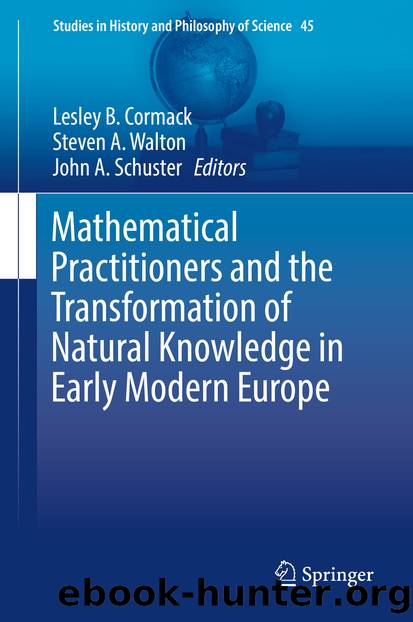Mathematical Practitioners and the Transformation of Natural Knowledge in Early Modern Europe by Lesley B. Cormack Steven A. Walton & John A. Schuster

Author:Lesley B. Cormack, Steven A. Walton & John A. Schuster
Language: eng
Format: epub
Publisher: Springer International Publishing, Cham
5.3 Conclusion: The Rise of the Military Mathematical Practitioner
It seems clear from surviving documents such as gunnersâ notebooksâmanuscripts not apparently designed as formal treatises, publications, or presentation piecesâthat geometry, instruments, measuring, and recipes (especially fireworks) were seen as keys to self-development and definition. When the technical ideas upon which the new military technologies of gunnery and fortification began to appear in didactic print treatises, they were received as branches of the mathematics . That these treatises may not have been supremely useful for the practical undertaking of any of these arts is relatively unimportant; the textbook-like nature of the print treatises reinforces the idea that general mathematical rules could be devised and deployed for military action, and by extension, for society more widely conceived. Military commanders increasingly saw military activities of gunnery, fortification, troop mustering, and provisioning as mathematical and the new polygonal fortification style obviated any real questioning of this assumption. Elites also invested, literally, in buying fine mathematical instruments for military tasks. Whether they used them at all is another question entirely.66
All that remains here, then, is to consider howâand how wellâthe military mathematical practitioners promoted their skills as mathematicians in order to secure patronage, obtain jobs, define the field, and advance the art itself. Their overall success in all these strategies varies greatly. By the end of the seventeenth century there was very little change in England for gunners : they had become regular employees of the Ordnance Office or of town corporation and their position in the hierarchy leveled off or even declined slightly by the time of the Civil War .67 The position of fortification engineer had been rare and relatively prestigious in the sixteenth century and one which England mostly asked Continental âexpertsâ to fill, but with the need for a great number of field fortifications during the Civil War, design and construction along geometrical lines became a matter of general instruction for trained bands in many cities.68 Both mathematical technologies became to some extent gentlemanly pursuitsâgentlemen often owned books on both gunnery and fortification, prints of fortification design, and fine instruments for bothâbut only the fortification engineers became marginally elite, the study being taught in academies and by royal tutors as the proper role of the aristocracy.
The same cannot quite be said about the practice of gunnery . For gunners, objects became a defining element of self-presentation, even if others were not fully ready to accept the new self-definition of the military mathematical practitioner. This accounts for a surprising lack of attention paid to these actors by their audience (the State) and explains the failure of the military mathematical practitioners to gain any real status in Renaissance England (Mario Biagoli has shown that the Italian case is, as always, rather different)69 until well into the later seventeenth and eighteenth centuries, by which time they are absorbed into a larger military bureaucratic network of planners and general staff. Socially, gunners became soldiers while fortifiers became architects.70 This distinction may have been a result of
Download
This site does not store any files on its server. We only index and link to content provided by other sites. Please contact the content providers to delete copyright contents if any and email us, we'll remove relevant links or contents immediately.
| Applied | Geometry & Topology |
| History | Infinity |
| Mathematical Analysis | Matrices |
| Number Systems | Popular & Elementary |
| Pure Mathematics | Reference |
| Research | Study & Teaching |
| Transformations | Trigonometry |
Modelling of Convective Heat and Mass Transfer in Rotating Flows by Igor V. Shevchuk(6408)
Weapons of Math Destruction by Cathy O'Neil(6220)
Factfulness: Ten Reasons We're Wrong About the World – and Why Things Are Better Than You Think by Hans Rosling(4715)
A Mind For Numbers: How to Excel at Math and Science (Even If You Flunked Algebra) by Barbara Oakley(3262)
Descartes' Error by Antonio Damasio(3250)
Factfulness_Ten Reasons We're Wrong About the World_and Why Things Are Better Than You Think by Hans Rosling(3218)
TCP IP by Todd Lammle(3158)
Fooled by Randomness: The Hidden Role of Chance in Life and in the Markets by Nassim Nicholas Taleb(3083)
Applied Predictive Modeling by Max Kuhn & Kjell Johnson(3043)
The Tyranny of Metrics by Jerry Z. Muller(3032)
The Book of Numbers by Peter Bentley(2935)
The Great Unknown by Marcus du Sautoy(2664)
Once Upon an Algorithm by Martin Erwig(2625)
Easy Algebra Step-by-Step by Sandra Luna McCune(2606)
Lady Luck by Kristen Ashley(2556)
Police Exams Prep 2018-2019 by Kaplan Test Prep(2517)
Practical Guide To Principal Component Methods in R (Multivariate Analysis Book 2) by Alboukadel Kassambara(2515)
All Things Reconsidered by Bill Thompson III(2374)
Linear Time-Invariant Systems, Behaviors and Modules by Ulrich Oberst & Martin Scheicher & Ingrid Scheicher(2348)
